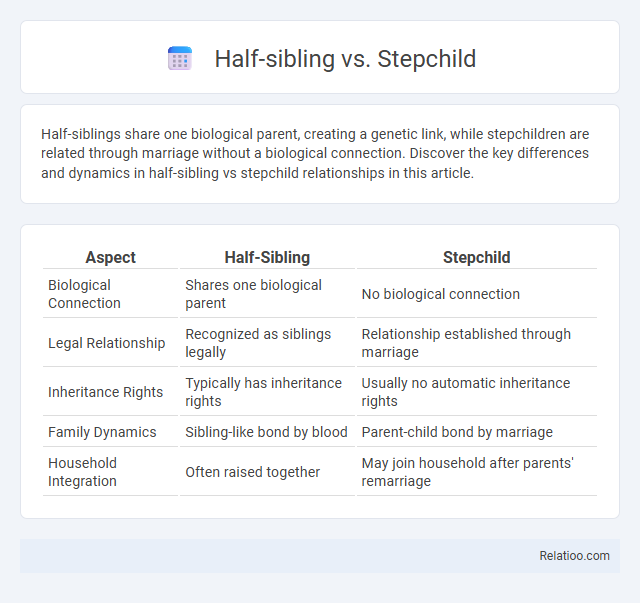Half-siblings share one biological parent, creating a genetic link, while stepchildren are related through marriage without a biological connection. Discover the key differences and dynamics in half-sibling vs stepchild relationships in this article.
Table of Comparison
| Aspect | Half-Sibling | Stepchild |
|---|---|---|
| Biological Connection | Shares one biological parent | No biological connection |
| Legal Relationship | Recognized as siblings legally | Relationship established through marriage |
| Inheritance Rights | Typically has inheritance rights | Usually no automatic inheritance rights |
| Family Dynamics | Sibling-like bond by blood | Parent-child bond by marriage |
| Household Integration | Often raised together | May join household after parents' remarriage |
Understanding Family Terminology
Understanding family terminology is essential for clarifying relationships, especially when distinguishing between half-siblings and stepchildren. A half-sibling shares one biological parent with you, either your mother or father, while a stepchild is the child of your spouse but not biologically related to you. Recognizing these distinctions helps you navigate family dynamics and legal considerations with precision.
Defining Half-Sibling Relationships
Half-sibling relationships involve two individuals sharing one biological parent, either mother or father, leading to a genetic connection that is distinct from stepchild or step-sibling bonds. Stepchildren are related through marriage rather than blood, with no shared genetic lineage, while half-siblings share approximately 25% of their DNA due to their common parent. Understanding these distinctions helps clarify family dynamics and inheritance rights, which can be critical in legal and personal contexts involving your family structure.
What is a Stepchild?
A stepchild is your spouse's child from a previous relationship, with no biological connection to you. Unlike a half-sibling, who shares one biological parent with you, a stepchild is related through marriage rather than genetics. Understanding this distinction helps clarify family dynamics and legal considerations in blended families.
Key Differences Between Half-Siblings and Stepchildren
Half-siblings share one biological parent, inheriting a portion of DNA from the same mother or father, while stepchildren have no genetic connection to you but become part of your family through marriage. Legal and emotional relationships differ; half-siblings often have shared family ties and history, whereas stepchildren may require intentional bonding and legal considerations. Understanding these distinctions helps clarify your role and responsibilities in blended family dynamics.
Legal Implications of Each Relationship
Legal implications for half-siblings typically involve inheritance rights and family law matters, where they may share genetic ties but do not have automatic legal standing unless recognized explicitly. Stepchildren, lacking a biological connection, usually require formal adoption to gain legal rights similar to biological children, affecting custody, inheritance, and benefits access. In contrast, full siblings have well-established legal rights regarding inheritance, custody disputes, and familial responsibilities, often protected by state laws and statutes.
Emotional Dynamics in Blended Families
Emotional dynamics in blended families often involve complex relationships between half-siblings, stepchildren, and half-siblings, where attachment, identity, and loyalty challenges arise. Half-siblings share a biological connection that can foster a sense of kinship and shared history, while stepchildren may experience feelings of exclusion or competition for parental attention. Effective communication, empathy, and family counseling play critical roles in navigating these emotional intricacies and fostering harmonious bonds.
Inheritance Rights: Half-Sibling vs Stepchild
Half-siblings share biological parents, granting them recognized inheritance rights under most intestate succession laws, while stepchildren typically have no automatic inheritance rights unless legally adopted or included in a will. Your estate planning should clearly specify any intentions toward stepchildren to ensure they receive assets, as the law generally prioritizes blood relatives like half-siblings in inheritance claims. Understanding these distinctions is crucial for managing family inheritance dynamics and avoiding unintended disinheritance.
Navigating Parenting Roles
Navigating parenting roles involves understanding the distinct relationships between a half-sibling, stepchild, and half-sibling, where half-siblings share one biological parent, stepchildren are the children of your spouse but not biologically related to you, and half-siblings provide unique bonds through shared genetics. You must balance emotional dynamics and establish clear boundaries to foster healthy family interactions. Effective communication and empathy are essential in managing these blended family structures.
Common Challenges in Mixed Families
Half-siblings, stepchildren, and full siblings in mixed families often face common challenges such as loyalty conflicts, differing parental expectations, and navigating blended family dynamics. Emotional bonding can be complicated by split custody arrangements and varying degrees of parental involvement, which may lead to feelings of favoritism or exclusion. Establishing clear communication, consistent routines, and mutual respect is critical to fostering healthy relationships among half-siblings and stepchildren in these blended family structures.
Building Strong Bonds Among Siblings and Stepchildren
Building strong bonds among half-siblings and stepchildren requires understanding their unique family dynamics and fostering open communication to promote trust and empathy. You can encourage shared activities and traditions that create positive experiences, helping to bridge differences and establish lasting connections. Recognizing each child's individual needs and offering consistent support strengthens relationships, creating a harmonious blended family environment.

Infographic: Half-sibling vs Stepchild
 relatioo.com
relatioo.com